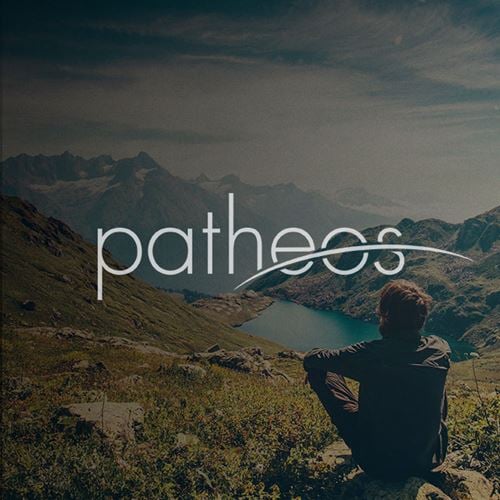- Trending:
- Forgiveness
- |
- Resurrection
- |
- Joy
- |
- Feminism
- |
- Afterlife
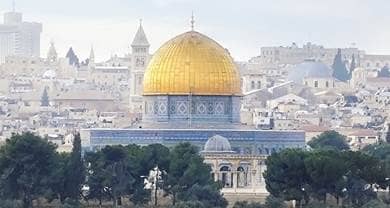
RELIGION LIBRARY
Islam
Symbolism
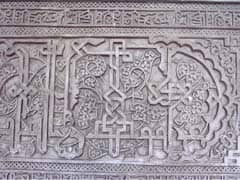 The absence of representations of human or divine figures in mosques, monuments, and other public buildings is in striking contrast to the decorative arts of other religious traditions, such as Christianity and Hinduism. The absence of human or other figures reflects the Islamic belief that an attempt to create a human figure is an attempt to rival God, who is the creator and sustainer of all life. Instead, Islamic art and architecture are both renowned for delicately conceived patterns of interlaced lines in a style known as arabesque, and intricate surface patterns conceived in vivid colors. Artists have produced many beautiful realizations of the phrase Bismallah ("In the name of God, the Merciful and Compassionate") in either the Kufic (geometric) style of calligraphy, or the flowing style known as naksh. These sometimes serve as symbols of Islam.
The absence of representations of human or divine figures in mosques, monuments, and other public buildings is in striking contrast to the decorative arts of other religious traditions, such as Christianity and Hinduism. The absence of human or other figures reflects the Islamic belief that an attempt to create a human figure is an attempt to rival God, who is the creator and sustainer of all life. Instead, Islamic art and architecture are both renowned for delicately conceived patterns of interlaced lines in a style known as arabesque, and intricate surface patterns conceived in vivid colors. Artists have produced many beautiful realizations of the phrase Bismallah ("In the name of God, the Merciful and Compassionate") in either the Kufic (geometric) style of calligraphy, or the flowing style known as naksh. These sometimes serve as symbols of Islam.

Many non-Muslims think of the hijab (veil) or the sword as symbols of Islam, but these are not symbols the Muslims themselves use. Nor is the symbol of the crescent moon and star universally accepted by Muslims, although it is widely regarded as an international symbol of the faith. The symbol of the crescent moon and star is older than Islam, probably dating to pre-Christian Byzantium. When the Ottoman Turks conquered the Byzantine Empire and captured its capital city 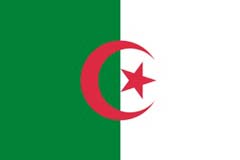 Constantinople in the mid-15th century, the Ottoman Empire adopted the city's existing flag and symbol of crescent moon and star as its own. In the modern world, a number of Islamic nations have a version of the crescent moon and star on their flags, including Algeria, Malaysia, Pakistan, Turkmenistan, and Turkey.
Constantinople in the mid-15th century, the Ottoman Empire adopted the city's existing flag and symbol of crescent moon and star as its own. In the modern world, a number of Islamic nations have a version of the crescent moon and star on their flags, including Algeria, Malaysia, Pakistan, Turkmenistan, and Turkey.
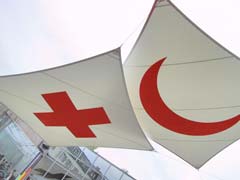 The Red Crescent is one of the internationally-recognized symbols of the International Red Cross and Red Crescent Movement, an international volunteer humanitarian movement dedicated to protecting human life and health, and preventing and alleviating human suffering. The Red Cross and the Red Crescent are placed on humanitarian vehicles and buildings during wartime to protect them from military attack. The International Committee of the Red Cross was founded in 1863 in Switzerland, and has unique authority under international humanitarian law to protect the victims of armed conflict. A few years later, during the Russo-Turkish war of 1876-1878, the Ottoman Empire replaced the Red Cross with a Red Crescent, fearing that the cross would alienate Turkish Muslim soldiers. The International Committee of the Red Cross secured Ottoman agreement that it would respect the sanctity of the emblem of the Red Cross, and Russian agreement that it would respect the sanctity of the Red Crescent.
The Red Crescent is one of the internationally-recognized symbols of the International Red Cross and Red Crescent Movement, an international volunteer humanitarian movement dedicated to protecting human life and health, and preventing and alleviating human suffering. The Red Cross and the Red Crescent are placed on humanitarian vehicles and buildings during wartime to protect them from military attack. The International Committee of the Red Cross was founded in 1863 in Switzerland, and has unique authority under international humanitarian law to protect the victims of armed conflict. A few years later, during the Russo-Turkish war of 1876-1878, the Ottoman Empire replaced the Red Cross with a Red Crescent, fearing that the cross would alienate Turkish Muslim soldiers. The International Committee of the Red Cross secured Ottoman agreement that it would respect the sanctity of the emblem of the Red Cross, and Russian agreement that it would respect the sanctity of the Red Crescent. 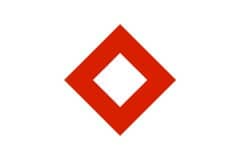 The International Federation of Red Cross and Red Crescent Societies was founded in 1919, and the Red Crescent was formally recognized in the Geneva Conventions of 1929. Today, the two emblems fly together outside the movement's museum in Geneva, along with the recently-added Red Crystal.
The International Federation of Red Cross and Red Crescent Societies was founded in 1919, and the Red Crescent was formally recognized in the Geneva Conventions of 1929. Today, the two emblems fly together outside the movement's museum in Geneva, along with the recently-added Red Crystal.
The color green is also traditionally associated with Islam. Although the origins of this are obscure, by the time of the Crusades, the European Crusaders avoided using the color green in their coats of arms so that they would not be mistaken for Muslims during battle. Some believe that the color green was the color of Muhammad's tribe, the Quraysh, while others believe that green was the Prophet's favorite color, and that he always wore a green turban.  Others associate the color green with a hadith attributed to Muhammad, which says that "Three things of this world are acceptable: water, greenery, and a beautiful face." Still others find special status attributed to the color green in the Quran, which says in surah 18:31 that in paradise, the blessed will wear garments of green silk. Covers of green silk cover the graves of Sufi saints, and Qurans are bound in green. A number of flags of the Islamic world are green, including those of Iran and Libya.
Others associate the color green with a hadith attributed to Muhammad, which says that "Three things of this world are acceptable: water, greenery, and a beautiful face." Still others find special status attributed to the color green in the Quran, which says in surah 18:31 that in paradise, the blessed will wear garments of green silk. Covers of green silk cover the graves of Sufi saints, and Qurans are bound in green. A number of flags of the Islamic world are green, including those of Iran and Libya.
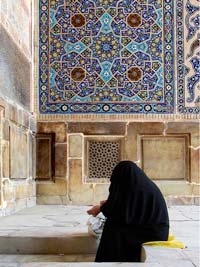 The colors white and black also have symbolic meaning in Islam. White symbolizes purity and peace, and many Muslims wear white when attending Friday prayers, or while performing the sacred rites of pilgrimage. Devout Iranian Shi'i women wear black chador, and the Iranian ayatollahs wear black cloaks. The male sayyid, or descendants of the Prophet Muhammad through his daughter Fatima and son-in-law Ali, wear black turbans. Blue is a color of protection and many mosques are beautifully decorated with blue turquoise, blue tile, and blue paint.
The colors white and black also have symbolic meaning in Islam. White symbolizes purity and peace, and many Muslims wear white when attending Friday prayers, or while performing the sacred rites of pilgrimage. Devout Iranian Shi'i women wear black chador, and the Iranian ayatollahs wear black cloaks. The male sayyid, or descendants of the Prophet Muhammad through his daughter Fatima and son-in-law Ali, wear black turbans. Blue is a color of protection and many mosques are beautifully decorated with blue turquoise, blue tile, and blue paint.
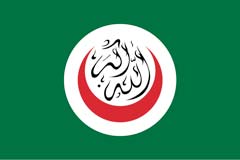 The flag of the Organization of the Islamic Conference coordinates several of the central symbols of Islam, including the color green, the Red Crescent on a white disk, and the words "God is great" (Allahu akbar) in Arabic calligraphy. The Organization of the Islamic Conference, with 57 member states, is an international organization with a permanent delegation to the United Nations.
The flag of the Organization of the Islamic Conference coordinates several of the central symbols of Islam, including the color green, the Red Crescent on a white disk, and the words "God is great" (Allahu akbar) in Arabic calligraphy. The Organization of the Islamic Conference, with 57 member states, is an international organization with a permanent delegation to the United Nations.
Study Questions:
1. Why are there no depictions of the prophet Muhammad or Allah?
2. Where did the red crescent moon symbol originate? What is its relationship to Islam?
3. What colors are associated with Islam? Why?








